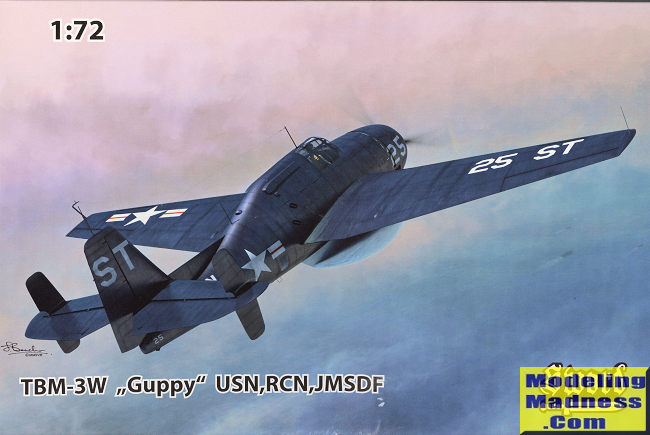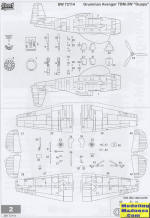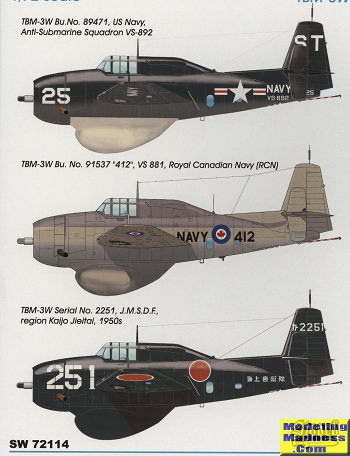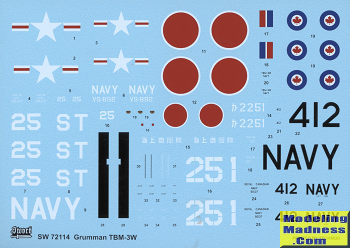
Sword 1/72 TBM-3W "Guppy"
| KIT #: | SW 72114 |
| PRICE: | $26.00 by the time it reached my door |
| DECALS: | Three options |
| REVIEWER: | Scott Van Aken |
| NOTES: | Short run. |

| HISTORY |
The Eastern TBM-3W Avenger was an airborne early warning radar aircraft
developed during the Second World War but that only entered service in May 1946.
Work on airborne warning radar began early in 1942 at the Radiation Lab at MIT
(Project Cadillac). At this point radar was becoming common on warships, but a
radar set mounted on a 50ft mast could only detect low flying aircraft at very
close range - 20 miles for an aircraft at 500ft. For an aircraft flying at
300mph this only amounted to a four minute warning.
Although the Avenger had not yet entered service it was the obvious aircraft to carry the new radar set, being one of the largest aircraft then operating from carriers, and with a large internal bomb bay. The resulting APS-20 radar set had an 8ft by 3ft antenna, the largest that would fit between the undercarriage legs of the Avenger. The radar set was mounted in the forward part of the bomb bay, with the antenna protected by a massive fibreglass radome. Two radar operators were located in the radio operator's station at the rear of the aircraft, while the turret was removed and a new single place cockpit with a turtle-back fairing replaced the greenhouse. At the same time as gaining a second crewman the radio operator's compartment lost some space as the 'tunnel' was smoothed off to improve the aircraft's rear ground clearance.
The rest of the fuselage was filled with electrical equipment, including two VHF radios, IFF gear, the rest of the radar set and data link relay equipment that could transmit the radar data to another aircraft or to the ground. Finally auxiliary tail fins were added near the tips of the horizontal stabilisers to improve lateral stability.
The XTBM-3W prototype made its maiden flight on 5 August 1944, and was successful enough to encourage the Navy to order a number of conversions. The urgency of this programme dramatically increased after the start of large scale kamikaze attacks, and forty radar sets were produced. Air crews were training with the new aircraft early in 1945, but this training period lasted so long that the war ended before they could join the fleet.
The TBM-3W joined the fleet in May 1946, and was soon paired with the TBM-3S in hunter-killer anti-submarine teams. The powerful radar in the -3W would be used to find a potential Soviet submarine, guiding the -3S onto its target. The -3W remained in service with the US fleet until the mid 1950, when it was replaced by early warning versions of the Grumman AF Guardian and Douglas AD Skyraider.
Interestingly, the APS-20 radar used in this aircraft was used in the EP-3B/E and the Shackleton as well as the P-2 and a number of other aircraft. Despite it being a vacuum tube system, it was easy to maintain, with modular circuit boards. It may well still be in service. During my time with VQ-1 when testing the system in the maintenance shop (VQ-1 had their own AIMD in Atsugi) the system would transmit into a dummy load. It got warm enough to help heat up the shop when working late in the winter. The base turned off the steam heat in shop spaces in the late afternoon and transferred that to the barracks.
| THE KIT |
 I
am quite pleased to see this kit being released as it saves me the effort of
trying to scratch build something to duplicate it. Typical of Sword kits, it is
short run. This means no alignment pins and the large pieces have short ejector
towers that will need to be removed in many cases to get other parts to fit. An
interesting note is that the instructions call for the interior to be bronze
green and the wheel wells to be interior green.
I
am quite pleased to see this kit being released as it saves me the effort of
trying to scratch build something to duplicate it. Typical of Sword kits, it is
short run. This means no alignment pins and the large pieces have short ejector
towers that will need to be removed in many cases to get other parts to fit. An
interesting note is that the instructions call for the interior to be bronze
green and the wheel wells to be interior green.
The cockpit is quite basic as things go with just a floor, rear bulkhead, seat, stick, instrument panel and rudder pedals. Adequate for the scale, but many will want to at least install some sort of seat harness. Before closing the fuselage halves, an engine face and tail gear assembly will need to be installed along with a number of small windows. These all fit from the inside so you'll need to do some masking or prepaint the fuselage halves before closing.
Wings are upper and lower halves for left and right sides. The
main ge ar
wells are each four pieces that are attached prior to gluing the wings. No
separate flaps or ailerons. Same for the tailplane pieces which are upper and
lower halves. The additional finlets for the tailplanes fit on small stubs. Main
landing
ar
wells are each four pieces that are attached prior to gluing the wings. No
separate flaps or ailerons. Same for the tailplane pieces which are upper and
lower halves. The additional finlets for the tailplanes fit on small stubs. Main
landing  gear
is nicely done and can be installed after the kit is painted. There are also a
lot of little rectangles to install along the upper portion of the fuselage
which I can only assume are hand and foot holds. There are more for the US plane
than the others.
gear
is nicely done and can be installed after the kit is painted. There are also a
lot of little rectangles to install along the upper portion of the fuselage
which I can only assume are hand and foot holds. There are more for the US plane
than the others.
Instructions are well done and a new fold-out type I've not seen with Sword kits in the past. There camouflage schemes are in full color with the box art plane being in overall gloss sea blue with an unpainted fibreglass radome. There is a Canadian version in dark sea grey over light sea grey. The third option is a JMSDF aircraft, also in overall gloss sea blue. The decals are superblly done and will prove to be quite thin.
| CONCLUSIONS |
Glad to see this one done. It doesn't look to daunting and should make for a very nice model. There is also another boxing with other markings options.
| REFERENCES |
http://www.historyofwar.org/articles/weapons_eastern_TBM-3W_Avenger.html
July 2018 Copyright ModelihgMadness.com Thanks to me
for the review kit. You can find this kit at your favorite hobby shop
or on-line retailer If you would like your product reviewed fairly and fairly quickly, please
contact
the editor or see other details in the
Note to
Contributors. Back to the Main Page
Back to the Review
Index Page
Back to the Previews Index Page